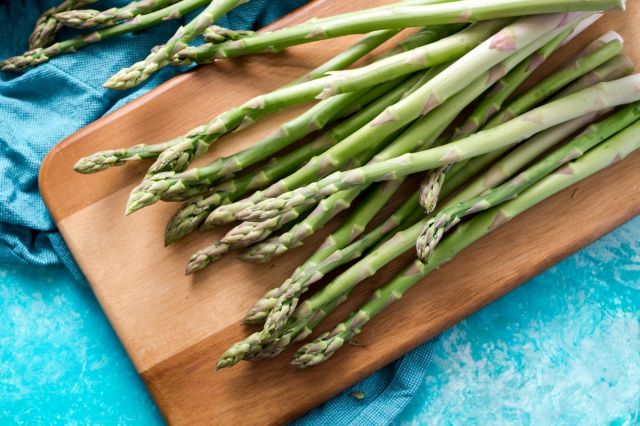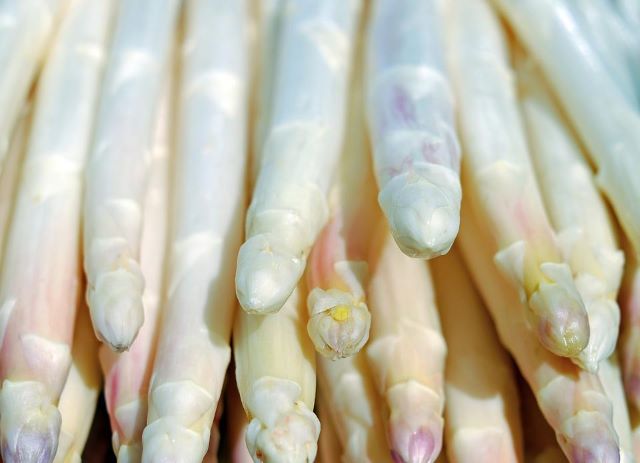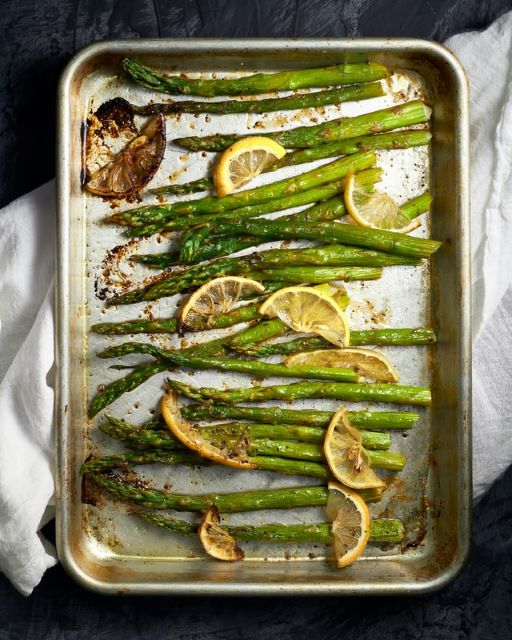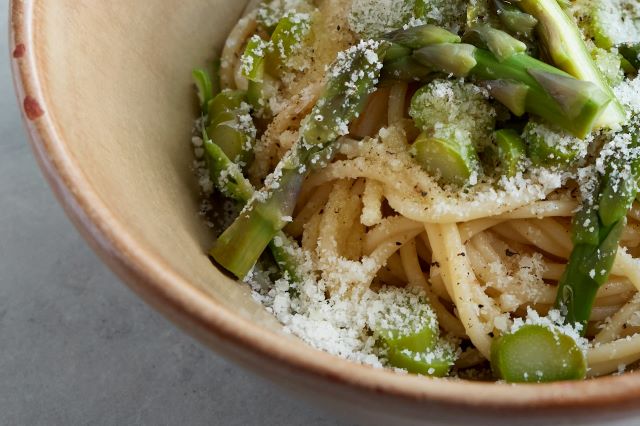Asparagus is a perennial vegetable that is both delicious and versatile. Prepared correctly it makes a tasty and nutritious addition to almost any meal. But asparagus can be bitter. So in this article, I’ll run you through why asparagus is bitter as well as choosing and preparing asparagus so that you can use it with confidence.

The most common reason asparagus is bitter is due to early harvesting which prevents the natural sugars from developing.
Read on to find out why asparagus is harvested before it sweetens up and ways to overcome the bitterness.
Table of Contents
A Minefield of Asparagus Myths
If you want to set the internet on fire, just get into the thorny subject of asparagus recipes. It’s not quite as contentious as discussing the NRA or Wade v Roe, but it’s pretty close. I’m going to try to break things down for you to make the whole process less complicated.
One of the reasons for much of the confusion around asparagus is that people tend to lump the preparation of green asparagus shoots with that of white asparagus shoots. They need to be treated very differently.
What Exactly is Asparagus?
The asparagus that you buy at the market or vegetable department are the sprouting shoots of a perennial vegetable. Between Easter and June of each year, the asparagus rhizome (root ball) will push up new shoots which the farmer harvests every day or two. Depending on the growing method, these asparagus shoots can be pencil thin and green. Or the asparagus spears can be thicker than your finger and white or slightly purple.
An asparagus plant can continue producing new shoots, (spears) for as long as twenty years. The new asparagus growth which you find on sale will have had very little exposure to daylight which accounts for the slightly bitter taste. Quite simply, the asparagus has not had enough time in the sun to develop sugars.
You could be forgiven for asking why not just pick the asparagus later so that the sugars can develop? The problem is that the older the asparagus spears become, the woodier they will be. Asparagus spears need to be young and tender to remain edible.
Overcoming Bitter Asparagus
The first step towards delicious asparagus is to choose your produce carefully. You want your asparagus spears to be as fresh as possible.
Look for healthy-looking asparagus shoots and don’t wait too long before cooking them.
Avoid asparagus spears that look woody or have brown or dry patches.
How to Sweeten Bitter Asparagus
If the flavor of your asparagus is too bitter, here are two hacks that can be used to sweeten them up.
One is the simple addition of sugar to the boiling water. If you toss in a teaspoon of sugar per bunch of asparagus spears it will sweeten the taste.
The Germans float a bread roll in the water and this is suggested to absorb any bitterness that might be generated during the blanching process. Personally, I find this method to have only marginal results. But it might just reduce the asparagus bitterness to make it more palatable.
Green Asparagus Verses White Asparagus
The difference between green asparagus and white asparagus is that the green is exposed to sunlight during the growing process. While the white asparagus is grown in the dark.
In Europe, the white version is more highly prized, while the green version is more common in the US.
Green asparagus is more tender and therefore the preparation is not the same. It has a more grassy taste which some say is bitter and others say is sweeter than the white.
Preparation of White Asparagus Spears

Having chosen your asparagus, we now come to the contentious issue of how to prepare them. If you have thick white stemmed asparagus, you will need to cut off the woody section at the base of each spear. Even the method of doing this generates debate.
I find that the simplest method is to press the blade of a sharp knife into the asparagus stem about one inch (25 mm) from the base. If it goes in smoothly, the asparagus spear base can be cut there. If it is tough and woody, the knife blade will need to be placed higher up the asparagus stem until tender plant material is found.
Once the woody asparagus bases have been chopped off and disposed of, the spears can be peeled using a vegetable peeler or a sharp knife. Peel from the base of the asparagus spear upwards and the tender portion at the top will not need to be peeled at all.
Cooking White Asparagus
Blanching is the simplest and most common method of cooking asparagus. Stand your asparagus spears in a saucepan of heavily salted boiling water so that the stems are submerged but the tender tips of the spears are not. The steam generated around the stems will be enough to cook the much softer tips.
Cooking time varies between fifteen and twenty minutes depending on the thickness of the asparagus spears. Poking a spear with the point of a sharp knife will quickly tell you if they are tender enough or not.
Once cooked, toss the asparagus spears into a container of iced water. The cooling will stop the cooking process and help retain their color.
Preparing Green Asparagus
As with the white asparagus version, you will still need to check for woodiness at the base of the stems. But green asparagus spears tend to have less woody material.
If the asparagus spears are young and tender, they will not need to be peeled.
Remember that your purchasing decisions always count so you will need to look for soft green asparagus shoots when buying.
Cooking Green Asparagus

Because we are dealing with a less woody material, cooking times are greatly reduced for green asparagus.
In fact, green asparagus is often eaten raw in threads or as a chopped gremolata added to a salad.
If you opt for either of these methods, preparation needs to be done just prior to serving. The asparagus spears will deteriorate rapidly once chopped or threaded.
If prep time is precious and you need to work in advance, stand the prepared asparagus in a bowl of water and place in the fridge until needed. The asparagus will remain viable this way for up to twenty-four hours.
For blanching green asparagus spears, they will only need a couple of minutes to cook through before being placed in the cold water to stop the cooking process.
Ideally, green asparagus should be slightly al dente when served. That crispiness adds a nice element of texture to the flavor.
Purple Asparagus
As if the confusion between green and white versions of this vegetable were not bad enough, the Italians went on to cultivate a purple variety. This was done in part to produce a different taste and texture.
Purple asparagus varieties have s a slightly nuttier taste. But in general, their texture aligns more with green asparagus and they can be treated in much the same way as their verdant cousins are. Being less woody, they don’t demand the longer cooking time that white spears do.
Asparagus Recipe Ideas

Once cooked, there are dozens of recipes that can be used that apply equally to both the green and the white asparagus, as well as purple. Asparagus can be seared or grilled. And don’t forget baking, roasting or sautéing.
These processes will add flavor but it is important to understand the cooking work needs to have been done during the blanching process. If you try to simply grill or fry raw asparagus it is likely to be tough and stringy.
Asparagus is often served cold with a drizzle of salad vinaigrette. It may sound counterintuitive but if you add lemon juice to the dressing it helps reduce that taste that some people describe as bitter.
We often see asparagus in soups, pasta, frittatas, and many more dishes. Even pizza!
So here are a few recipe ideas to try out using asparagus.
- Asparagus Salad with Lemon Vinaigrette – from The Recipe Critic.
- Grilled Asparagus with Lemon-Dijon Vinaigrette – from Daring Gourmet.
- Grilled Asparagus – from Foodie Crush.
- Perfect Roasted Asparagus – from Cookie and Kate.
- Spaghetti al Limone With Asparagus – from Bon Appetit.
- Asparagus Pizza – from Healthy Seasonal Recipes.
- Easy White Asparagus Recipe – from Braised and Deglazed.
- Roasted White Asparagus with Capers and Dill – from In The Kitch.
- White Asparagus Soup – from Kitchen Stories.
- The Best Purple Asparagus Recipe – from Marleys Menu.
Why You Should Eat Asparagus
Asparagus is high in fiber, low in calories and rich in both vitamins and macronutrients. So asparagus makes for a healthy addition to your dinner plate.
It’s particularly good as a source of vitamin K. And the high Potassium levels are helpful for reducing blood pressure.
What About the Asparagus After Smell?
Asparagus also contains asparagusic acid. When you eat it, it converts sulfur molecules so that they vaporize and you get that distinct odor when you pee.
It’s nothing to be concerned about and some experts suggest it is quite healthy.
Further reading:
